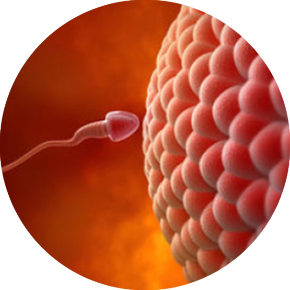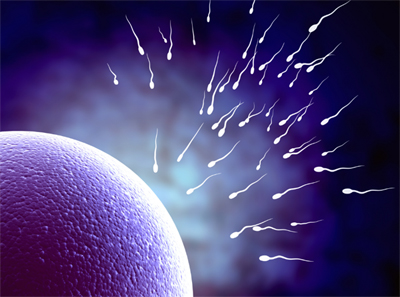Is the Egg more Powerful than the Sperm?

Understanding the Miracle of Conception
 For us humans, there is nothing quite as exciting as the miracle of conception, along with the complex biological processes and cultural practices that lead to the creation of a new life. The relationship between culture and biology yields endless insight for anyone who takes the time to explore and ponder. In a world ruled by force, and power, with a history of war, it is no wonder that our notion of conception would reflect the notion of the sperm penetrating the egg as if invading a foreign land. That's why recent discoveries about the moment of conception that reflect more on feminine receptivity, cooperation, and choice, as opposed to conquest, may provide a beautiful perspective into how we may want to reshape our culture to reflect our inner biology.
For us humans, there is nothing quite as exciting as the miracle of conception, along with the complex biological processes and cultural practices that lead to the creation of a new life. The relationship between culture and biology yields endless insight for anyone who takes the time to explore and ponder. In a world ruled by force, and power, with a history of war, it is no wonder that our notion of conception would reflect the notion of the sperm penetrating the egg as if invading a foreign land. That's why recent discoveries about the moment of conception that reflect more on feminine receptivity, cooperation, and choice, as opposed to conquest, may provide a beautiful perspective into how we may want to reshape our culture to reflect our inner biology.
As social beings, most of us spend a chunk of time animated by love, passion, and attraction. Bards would sing a song, or write a poem, bring flowers, duel and more to win the favor of a beautiful maiden. There are biological mechanisms that shape this behaviour that is central to much of our art and cultural treasures. Indeed it is a sacred, mysterious, cultural, and biological, cocktail of endless creative possibilities.
It Starts with a Kiss
Our nose and mouth are covered with an oily substance called sebum. Research shows that sebum contains pheromones, which are the chemicals that broadcast information about a person's biological makeup. The exchange of pheromones during a kiss, causes individuals to become more or less sexually attracted to each other, depending on what their biological systems detect. Apparently people prefer the pheromones of individuals who have a different type of immune system than their own. Evolutionary biologists believe that this genetic difference is good for the immune system of offspring.
“Today, the most widely accepted theory of kissing is that humans do it because it helps us sniff out a quality mate. When our faces are close together, our pheromones "talk" — exchanging biological information about whether or not two people will make strong offspring. – Livescience
Conscious Beings are Still Ruled by Biology
The neurobiology of love and relationships shows us that we can become addicts to our own neurotransmitters, yet our neo-cortex allows us to direct our conscious intention. It is this beautiful balance between unconscious drive and conscious intention that makes us humans so interesting (at least to ourselves). This is where cultural practices like sacred sexuality and tantra have become the refined expression of humanity living in harmony with our biological nature.
Sometimes the mind wants what the body doesn't want, and vice-versa. Sometimes the mind changes with the ebb and flow of hormones. No wonder we humans have developed such elaborate cultural traditions and myths to help us navigate this most primal drama. It can be a struggle, a conquest or even a harmonious dance, depending on how you most enjoy relating to it, but if it is filled with mutual respect it will always yield positive results.
“If an egg is broken by outside force, life ends. If broken by inside force, life begins. Great things always begin from inside. - Jim Kwik
The All-Powerful Egg
Everyone has heard the tired myth of the army of warrior sperm invading the uterus to save the damsel-in-distress (the dying egg), fighting each other along the way to dominate, with the winner penetrating the egg and creating life. 
The metaphor makes for great fairytales and Monty Python movies, but it is actually not very accurate biologically-speaking.
The sperm are actually weak swimmers, and the stronger ones help the weaker ones through the uterine mucous, similar to the way that migrating birds or a team of bicyclists take turns leading the way.
As the sperm arrive at the egg, it is the egg that chooses the sperm and pulls it towards her.
“Her (Emily Martin's) efforts to spotlight the male- skewed imagery that permeates our views of reproduction have placed her at the centre of a growing debate about how cultural myths can turn into scientific myths, and vice versa. - Discovery Magazine
To bust the common myth even more, the selected sperm actually tries to swim away from the egg but is tethered to the egg by female hormones. The membrane around the egg literally opens up and swallows the sperm. Though the fierce battle metaphor always has a winner dominate, it appears that this process is more about cooperation towards a shared desire to create life. It is now widely known and accepted that the womb and birth experience leave emotional imprints for the life of a being, indeed we each have our very own creation story!
“Prior to fertilization, a cloud of cumulus cells surrounding the egg release progesterone, the female sex hormone, triggering a calcium influx into the sperm. This flood of calcium causes the sperm to beat their flagella rapidly, an action necessary to penetrate though the egg's protective jelly-like protein coating. Progesterone has also been implicated in providing a chemical gradient by which sperm can navigate toward the egg. - The Scientist
To Conquer or Cooperate?
Manipulating and controlling outcomes is something that humans do quite well. Each gender has it's own style, strengths and weaknesses when it comes to the lure of romance leading to procreation. How does the myth versus the biological reality shape the way we engage in this dance? The knight in shining armor and damsel in distress myth has been adopted in social dynamics well beyond the movies or fairytales. The world is ruled by stories… How does the world change when our stories for describing it change?
Emily Martin, a Ph.D in Cultural Anthropology, has spent much time exploring this concept and the way it influences scientific inquiry, as well as social beliefs about human biology, our bodies, and the world around us. In her book, The Woman in the Body: A Cultural Analysis of Reproduction, she studied the dialectic between medical metaphors for women's reproductive processes and women's own views of those processes. Scott Gilbert, a developmental biologist at Swarthmore College "prefers to think of the egg as engaging in a dialog with the sperm rather than gluing it down."
“If you don't have an interpretation of fertilization that allows you to look at the egg as active, you won't look for the molecules that can prove it. You simply won't find activities that you don't visualize. - Scott Gilbert
We all look to science, yet scientists are also influenced by our cultural myths and attitudes. Humans are being invited to cooperate in unprecedented ways as we address global climate issues. The notion of conquest no longer serves us as a way of relating across genders or in the way we engage with our environment. Biological observation, just like spiritual mindfulness and presence, can show us new ways to shape our lives, culture, and world. It is a subtle and beautiful dance that requires equal parts listening, observing, and action. We are all recipients of this gift called life, how will you give that gift back to the world around you?

